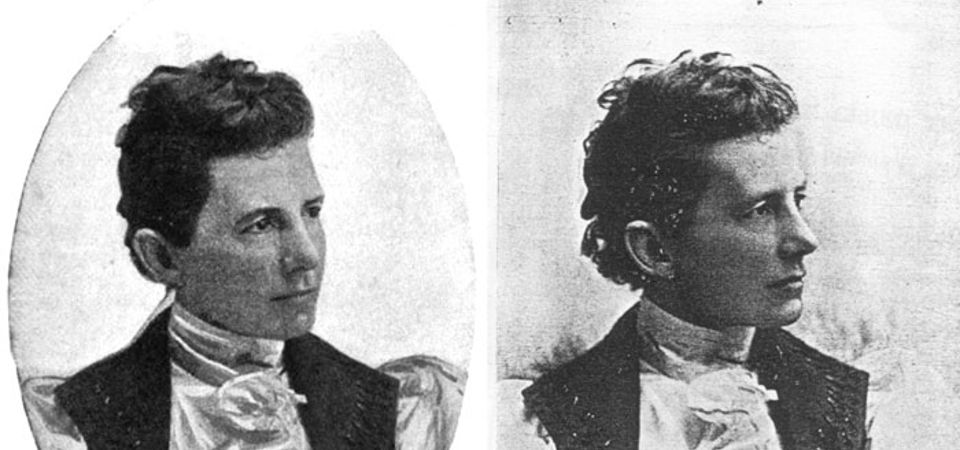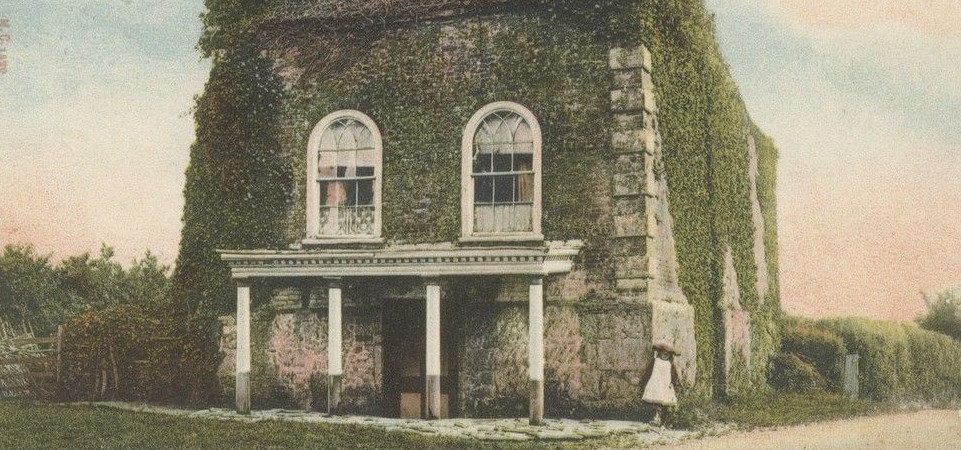These Hidden Heroes were nominated and submitted by Carisbrooke Castle Museum
Passionate about the historic and natural environment, a group of young women formed Ferguson’s Gang in 1927.
Inspired by the book ‘England and the Octopus’, by Clough Williams-Ellis, they wanted to help protect rural England from rapidly spreading urbanisation. They made many generous donations to the National Trust, and supported the growth of the organisation in their pursuit of conservation. This included saving Newtown Old Town Hall on the Isle of Wight.
Pseudonyms for the gang members
The Gang adopted pseudonyms, remaining anonymous during their lifetimes. The 6 core members were known as ‘Bill Stickers’, ‘Sister Agatha’, ‘Red Biddy/ White Biddy’, ‘The Lord Beershop of the Gladstone Islands and Mercator’s Projection’, ‘Kate O’Brien the Nark’ and ‘Shot Biddy’.
They enjoyed dressing up, adopting disguises, including masks.
Peggy led the Gang
The Gang’s leader, ‘Bill Stickers’, was the only one who formally revealed herself, as Peggy Pollard (nee Gladstone), in a letter sent on her instructions to The Times, after her death, aged 92.
It is only recently that others identities have been revealed. Their stories researched and compiled by Polly Bagnall and Sally Beck, in the book ‘Ferguson’s Gang’, published in 2015.
Peggy won a scholarship to Cambridge in 1921, aged 17, becoming the first female student to gain a Double First in Oriental languages there. She completed further research at university in London, writing a book that she was later awarded a PhD for – impressive achievements for a woman in the 1920s.
Unconventional record-breaking
Aged 70, Peggy unintentionally broke a world record, when she embroidered 1330 feet of cloth with scenes from the Narnia story – typical of Gang member’s undaunted approach to projects.
All the members had a great sense of fun, and were quite unconventional in their time. Some were lesbian or bisexual, some dressing in masculine outfits. They loved fine food, having Fortnum & Mason deliver hampers for meetings and excursions.
They were open to subscribing members, to help their funds and causes, with a diverse mix of people involved. The architect advising on properties they acquired was known as ‘The Artichoke’.
Countrywide conservation
The Gang secured the future for places such as Shalford Mill in Surrey (a room there was used for Gang meetings), as well as Newtown Old Town Hall on the Island.
They also funded the purchase of stretches of the coastline of Cornwall, Priory Cottages at Steventon in Oxfordshire, and supported appeals for money to purchase land in Derbyshire, the Lake District, Devon, and Wiltshire for the National Trust.
Media savvy
Whilst the Gang did not initially set out to seek press attention, they attracted a lot of publicity through their unusual acts of donation. They found they could use this to their advantage to further their causes.
One headline-grabbing occasion they triggered a bomb scare, after they deposited a metal pineapple at a National Trust AGM, which in fact enclosed £100.
The Island connection and saving Newtown
Anne Gladstone, the mother of ‘Bill Stickers’/ Peggy Pollard, moved to the Isle of Wight in 1922, following the death of her husband, John Gladstone (nephew of the former Prime Minister).
She lived at The Briary in Freshwater, which was the home built in 1873 for the artist G.F. Watts, at Tennyson’s suggestion, and was where the Watts, and Prinseps (Julia Margaret Cameron’s family) stayed.
Impressed by National Trust’s work
In February 1927, one of Anne’s close neighbours, the second Lord Tennyson, presented 155 acres of land – now known as Tennyson Down – to the National Trust, in memory of his father.
Seeing at close hand how the countryside could be protected by the Trust, may have provided some inspiration to Anne and Peggy for their future contributions.
Who will save the Old Town Hall?
It was during a stay at The Briary that Peggy/ ‘Bill’ first became aware of Newtown, after her mother had asked at a dinner party, ‘When is someone going to save the Old Town Hall at Newtown?’. The next day she cycled the eight miles to Newtown to inspect it.
Newtown had been a significant port in medieval times, with an official building on the site of the Town Hall since around the 13th century. In 1699 the Town Hall had been substantially rebuilt, with further 18th century alterations. After steady decline in the area, the building was in a very poor condition by the 1930s.
Bought for £5
The dilapidated Hall had captured Peggy’s imagination, and at a meeting in March 1933, it was suggested as the Gang’s second building project (after Shalford Mill).
It was purchased from Sir John Simeon for £5, and the neighbouring field for £100, but would take over £1,000 to repair (a considerable cost at the time).
The Gang visited on 17th March 1934 to inspect works, with a typically lavish picnic, and eccentric rituals to bless the place.
New life as a youth hostel
They concluded that it should have a use following its repair. They agreed, (with the National Trust), on the Youth Hostel Association (YHA) making use of it, provided the Gang may still occasionally visit, without becoming members themselves.
In December 1934, a payment for the Hall was delivered to the National Trust, along with a ‘bottle of poison’- sloe gin. The Town Hall was used as a Youth Hostel between 1935-1939. George Macauly Trevelyan was a member of the Gang, known as ‘Poolcat’, and had been responsible for establishing the YHA in Great Britain in 1931.
Helping people enjoy the countryside
Newtown was therefore a fairly early hostel, and shows the Gang’s fondness of supporting and promoting organisations which helped people to enjoy and preserve the countryside.
At Newtown, women slept upstairs, with the Council Chamber used as a Common Room, and the men slept downstairs, where remnants of the old kitchen and washrooms still survive.
Why Heroes?
Without the young women of the Ferguson’s Gang, it is unlikely that Newtown Old Town Hall would still be standing today.
Beyond the saving of this building, significant in the Island’s history, they also made important contributions to the growth of the National Trust, and other organisations, helping people to experience, enjoy, and conserve, the historic and natural environment of the UK.
Find out more about Ferguson’s Gang on the National Trust Website
Find out more about Newtown Old Town Hall on the National Trust Website



